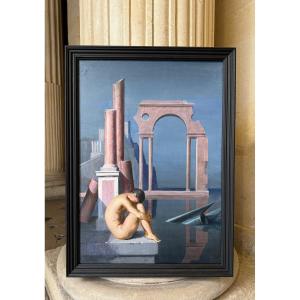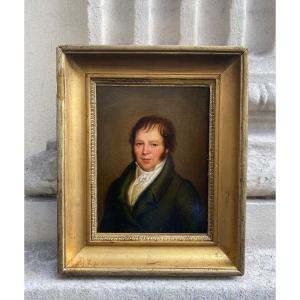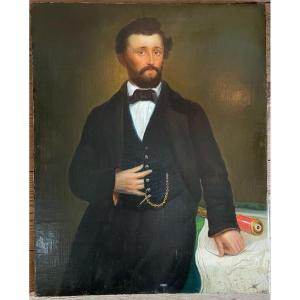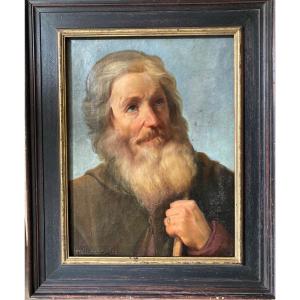Oil on canvas in a giltwood frame carved with laurel leaves. The painting represents an allegorical composition: two female figures dressed in antique style place a crown of flowers atop a medallion containing the portrait of an artist, palette and brushes in hand. A giltwood or bronze base made up of seated putti supports the tray on which the painting is placed.
The whole presents a careful staging, where portrait and neoclassical symbolism blend in a register celebrating the arts and painting. The Latin motto inscribed at the bottom, “Dulces ante omnia Musae”, borrowed from Virgil (Georgics), means: “The Muses are dear to me above all”.
The presentation both allegorical and personal is rare for a portrait of an artist, which gives it a singular character. In his features, expression, and attire, the central figure evokes Jean-Baptiste Isabey (1767–1855), a renowned painter, draftsman, and miniaturist. A pupil of David, he was one of the most highly regarded artists of his time, working for Napoleon Bonaparte as well as Louis XVIII, Charles X, and Louis-Philippe. His talent for miniatures and official portraits earned him early and lasting recognition. He notably participated in the organization of major imperial ceremonies and was appointed painter to the king's cabinet.
The figure depicted here shares several elements with known representations of Isabey: regular features, a sober hairstyle, elegant attire typical of the first Restoration, and a confident and benevolent air. The fact that he is represented with artist attributes in a symbolic and honorary scene reinforces the idea of a tribute paid to a recognized figure. If the identification cannot be affirmed with certainty, the quality of the representation and its celebratory character agree with what one could conceive for an artist of this renown
French school, circa 1810–1820.
Dimensions with frame: 44 x 36 cm
Very good general condition, beautiful frame Relinage.





































 Le Magazine de PROANTIC
Le Magazine de PROANTIC TRÉSORS Magazine
TRÉSORS Magazine Rivista Artiquariato
Rivista Artiquariato